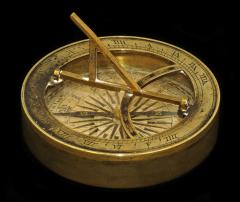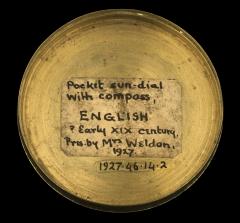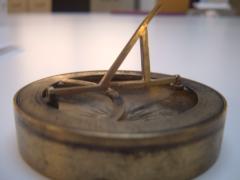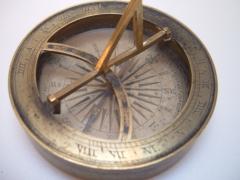ENGLAND: THE OTHER WITHIN
Analysing the English Collections at the Pitt Rivers Museum
The 'Weldon' Pocket Compass and Sundial
Katy Barrett,
Museum Volunteer
The Pitt Rivers Museum contains a large number of compasses ranging from Chinese to Indian to English. A selection is displayed to the back right of the Great Court under the Totem Pole. Mrs Weldon donated an English pocket compass and sundial to the museum in 1927 (Museum number:1927.46.14.1 and 1927.46.14.2). It is brass, approximately 65mm wide and 10mm thick. The compass-sundial has a lid and a hinged gnomon/style to make it portable. The sundial plate displays roman numerals and is cut away to a 5mm outer edge, allowing the compass rose to be viewed through a glass cover. The compass rose is divided into the basic 16 wind rhumbs with a separate dial showing 360°. North is marked by a fleur-de-lys .The centre of the rose shows a 32-point star. A blue metallic double needle points to both north and south with gold letters denoting both directions. The original Accession Book entry reads:
MRS WELDON , South Parks Road Oxford. Nov. - Brass-mounted compass with sun-dial in case for the pocket, ENGLAND
Science and Mathematical Instrumentation
Man has always relied on his natural environment, not only for resources, but for the ability to analyse his wider concerns. An eternal basic concern is for reliable knowledge of time and location. The sixteenth century discovery of the Americas and concurrent expansion of global trade led to economic rivalry and the need for accurate navigation, improving mathematical techniques. Accurate, scientific means of establishing time and location therefore began to be found. Instruments used for time-telling, navigation, surveying and astronomy are collectively known as mathematical instruments, as they function to take measurements, and work by a mathematical principle. The development of truly scientific instrumentation, and of its division and classification, dates largely to the seventeenth century and the birth of the Royal Society in England.
The compass and sundial are both mathematical instruments providing an accurate means of ascertaining time and location.
Sundials
A sundial functions to show the time of day by casting a shadow on a surface, which has been marked to show hours. They are evident in ancient Islamic, Roman and Greek cultures. Familiar today as garden ornaments, sundials have long been man's only means of calculating the time by use of sunlight and his own shadow. Some medieval houses show 'noon marks' in windowsills: a simple means of ascertaining noon without clocks. Some modern Asian post offices still use such marks to keep accurate time for their whole society. [1] In seventeenth and eighteenth century Europe, sundials remained necessary to ensure the accuracy of clockwork, as sundials measure time, where clockwork remains accurate to the time at which it is set. Most watch owners would also possess pocket sundials, and sundials as well as clocks adorned church towers to keep local time. The English were particularly prolific in the making of sundials. It was not until the spread of the railways in the nineteenth century, that time had to be kept accurately across the whole country, and thus the use of the electric telegraph to establish GMT made sundials redundant as timepieces. [2]
The most popular form of sundial is the horizontal dial, although column, horizontal and ring dials have also been used. Horizontal dials use a fixed gnomon or style to cast a shadow. The hour lines are projected by trigonometry to radiate out from the gnomon's base. The dial is in the horizontal plane and the gnomon points upwards parallel to the earth's axis. A horizontal dial can keep time all year where a vertical dial cannot. Some sundials also indicate the date by the shadow of a particular point, or nodus , on the gnomon . The dial face can also show other information such as the horizon, the equator, and the tropics. Use of curved hour lines or gnomons , or inclusion of a graph on the dial face allows for the 'equation of time' to be corrected. This is the variation between solar time and clock time caused by the earth's tilted axis and elliptical orbit. Horizontal dials are specific to one latitude unless provided with a range of hour marks.
The 'Weldon' sundial is a horizontal dial, so works only for the English latitude. It measures time through a hinged gnomon.
Compasses
A mariner's compass functions to establish the holder's position relative to the magnetic meridian by use of a magnetic needle. The earliest form of compass was the 'needle and bowl' compass, used universally until the thirteenth century. A needle, magnetized by rubbing it on silk, was placed in a straw and floated in water to become a compass. This could be used by mariners to establish a rough location in conjunction with astronomical observations and depth soundings. The development of the 'dry' box compass around 1300 is contested between Europe and China. The Pitt Rivers has eighteen Chinese compasses. Chinese literature first mentions a mariner's compass c.1044, European literature c.1190. [3] It now seems generally agreed that the compass did not come to Europe from China through the Middle East and the Silk Route, as it is mentioned in European works before Arabic ones. It must, therefore, either have spread from China direct to Europe, or developed independently in Europe. Evidence for the latter is seen in the differences between Chinese and European compasses, with the European needle pointing north where the Chinese needle generally points south, and the European compass card having sixteen rather than twenty-four basic divisions.The classic 'dry' compass is a single sealed instrument where a magnetised needle is free to turn on a central pivot. It thus consists of three parts: the box, the card, and the needle. [4] The card is traditionally divided into thirty-two points, or rhumb s, which follow wind directions. A compass can be used in conjunction with a marine chronometer to calculate longitude, and a sextant to calculate latitude, providing very accurate navigation. The compass' development materially improved exploration and trade, by making travel safer and more efficient. It is particularly useful where deep seas prevent soundings and weather conditions prevent celestial navigation. This extended the Mediterranean shipping season in the thirteenth century and allowed easier trade with Northern Europe.
The 'Weldon' compass is still correctly magnetised to north and incorporates a rose marked with the basic sixteen rhumbs and 360°. The needle allows both North and South to be read.
A pocket sundial and compass
The 'Weldon' sundial and compass not only combines both instruments but is also a portable version. Portable sundials developed as early watches in the Middle Ages. These were mainly diptych dials. Portable ring dials were created in the sixteenth century, and developed into flat dials by the eighteenth. This established the popular form of the pocket sundial: small, round, brass boxes with a lid to protect them in travel and a hinged gnomon. [5] This is the style of the 'Weldon' sundial and compass. In 1610, Edward Wright created the 'Sa Ring' which mounted a universal ring dial over a compass, allowing time and magnetic variation to be read together. [6] This developed into the compass dial which combines a pocket compass with a sundial. The introduction of a compass makes the pocket sundial more accurate as it does not require the user to know whether the hour is before or after noon. In a compass dial, the sundial's plate is reduced to the outer ring to allow the compass card and needle to be read through the centre.The fairly constant style of such pocket dials, combined with its brass material makes the 'Weldon' dial difficult to date. The style and its accession date suggest a date in the eighteenth or nineteenth centuries. The lack of a maker's mark, however, suggests it may have been mass-produced and therefore a late nineteenth century date.
Florence and Raphael Weldon
The history of the Weldons can suggest a tentative background to the pocket dial. It is likely that Mrs Weldon is the Florence Joy (née Tebb) who married (Walter Frank) Raphael Weldon in 1883. W.F.R. Weldon was a prominent zoologist, statistician, and biometrician. He was a founder member of the school of 'Biometrics' with his friend and colleague Karl Pearson, also acting as first editor of the journal Biometrika . He held the Jodrell Chair of Zoology at UCL, 1890-1899, and the Linacre Chair in Comparative Anatomy, at Oxford, from 1899 until his death in 1906. Florence Weldon accompanied her husband on his many research trips in search of data to demonstrate Darwinian natural selection. Such trips ranged from Naples to the Bahamas. Pearson records the Weldons' homes in both London and Oxford as a focus for wide-ranging discussion and debate. Both Weldons were members of the BAAS, W.F.R acting as President for a time.
Pearson's memorial article to W.F.R. Weldon, paints a picture of a remarkable man, dedicated to scientific enquiry and constantly pushing himself to establish new areas of Biometry, yet also hugely eclectic in his interests and particularly loyal and engaging. [7] Pearson discusses Weldon's especial interest in mechanics and instruments, for example, his construction of a camera to photograph the solar eclipse in 1905 with no prior expertise. The portable compass and sundial might therefore have been collected through his mechanical interests. His wide travels, fluency in a range of languages, and artistic talents and interests equally made Weldon the sort of man who would collect the range of European, Asian and African objects also donated to the museum by Mrs Weldon. Pearson records Weldon's love of the country and the open air, undertaking frequent bicycle rides to local churches or to collect specimens. Biometry 'picnics' appear to have been one of the features of his Oxford life. The pocket sundial and compass may, therefore, have been a basic instrument for use on such trips. Its very donation to the Pitt Rivers certainly suggests a treasured status.
Further Reading:
Evan, Lewis, 'Portable Sundials,' in Gatty, Mrs A., The Book of Sundials (eds. H.K.F. Eden and Eleanor Lloyd) (London, 1900)
L'E Turner, Gerard, Scientific Instruments 1500-1900: An Introduction (London, 1998)
O'Connor, J.J. and Robertson, E.F., " Walter Frank Raphael Weldon ," MacTutor History of Mathematics archive : http://www-history.mcs.st-andrews.ac.uk/Biographies/Weldon.html
Pearson, K., 'Walter Frank Raphael Weldon 1860-1906', Biometrika , Vol. 5, No. 1/2. (Oct., 1906), pp.1-52: www.jstor.org
1901 Census: http://www.1901censusonline.com
DNB: http://www.oxforddnb.com/view/article/36823/36823?back=,36823,28994
OED: www.oed.com on Compass n.1 and Sundial
Wikipedia: http://en.wikipedia.org/wiki/Walter_Frank_Raphael_Weldon
http://en.wikipedia.org/wiki/Sundial
http://en.wikipedia.org/wiki/Compass
[1] http://en.wikipedia.org/wiki/Sundial (27 th December 2007)
[2] L'E Turner, Gerard, Scientific Instruments 1500-1900: An Introduction (London, 1998) p.18
[3] http://en.wikipedia.org/wiki/Sundial (27 th December 2007)
[4] www.oed.com - Compass n.1
[5] Evan, Lewis, 'Portable Sundials,' in Gatty, Mrs A., The Book of Sundials (eds. H.K.F. Eden and Eleanor Lloyd) (London, 1900) p.195
[6] http://en.wikipedia.org/wiki/Sundial (27 th December 2007)
[7] Pearson, K., 'Walter Frank Raphael Weldon 1860-1906', Biometrika , Vol. 5, No. 1/2. (Oct., 1906) passim



